Research on the Features and Driving Factors of Shallow Groundwater Quality in Arid Areas, Northwest China
Abstract
1. Introduction
2. Materials and Methods
2.1. Overview of the Study Area
2.2. Geological and Hydrogeological Conditions
2.3. Sample Collection and Testing
2.4. Data Analysis Methods
Water Quality Index (WQI)
3. Results and Discussion
3.1. Pattern of Groundwater Quality in the Beichuan River Basin
3.2. Water Quality Assessment
3.3. Analysis of Groundwater Chemical Types
3.4. Controlling Factors and Origins of Groundwater Ions
3.4.1. Identify the Controlling Factors
3.4.2. Water–Rock Interaction
3.5. Human Activity Impact
3.6. Identification of Major Controlling Factors of Groundwater Hydrochemistry
3.6.1. Correlation Analysis
3.6.2. Principal Component Analysis
4. Conclusions
Supplementary Materials
Author Contributions
Funding
Data Availability Statement
Acknowledgments
Conflicts of Interest
References
- Wei, S.; Zhang, Y.; Cai, Z.; Bi, D.; Wei, H.; Zheng, X.; Man, X. Evaluation of groundwater quality and health risk assessment in Dawen River Basin, North China. Environ. Res. 2025, 264, 120292. [Google Scholar] [CrossRef] [PubMed]
- Qin, R.; Wu, Y.; Xu, Z.; Xie, D.; Zhang, C. Assessing the impact of natural and anthropogenic activities on groundwater quality in coastal alluvial aquifers of the lower Liaohe River Plain, NE China. Appl. Geochem. 2013, 31, 142. [Google Scholar] [CrossRef]
- Yang, M.; Zhu, L.; Liu, J.; Zhang, Y.; Zhou, B. Influence of water conservancy project on runoff in the source region of the Yellow River and wetland changes in the Lakeside Zone, China. J. Groundw. Sci. Eng. 2023, 11, 333–346. [Google Scholar] [CrossRef]
- Torres-Martínez, J.A.; Mahlknecht, J.; Kumar, M.; Loge, F.J.; Kaown, D. Advancing groundwater quality predictions: Machine learning challenges and solutions. Sci. Total Environ. 2024, 949, 174973. [Google Scholar] [CrossRef]
- El-Rawy, M.; Wahba, M.; Fathi, H.; Alshehri, F.; Abdalla, F.; El Attar, R.M. Assessment of groundwater quality in arid regions utilizing principal component analysis, GIS, and machine learning techniques. Mar. Pollut. Bull. 2024, 205, 116645. [Google Scholar] [CrossRef]
- Chandra, G.V.; Ghosh, P.K. Groundwater quality in high-sulfur coal mining region of India: Spatial distribution, source control, and health risk assessment. J. Environ. Manag. 2024, 368, 122281. [Google Scholar] [CrossRef]
- Deng, Y.; Lu, Y.; Du, X.; Ye, X.; Feng, J. Identifying spatial patterns and driving factors of anthropogenic impacts on the groundwater environment based on groundwater chemical kinetics. J. Clean. Prod. 2025, 486, 144436. [Google Scholar] [CrossRef]
- Huang, G.; Sun, J.; Zhang, Y.; Chen, Z.; Liu, F. Impact of anthropogenic and natural processes on the evolution of groundwater chemistry in a rapidly urbanized coastal area, South China. Sci. Total Environ. 2013, 463, 209. [Google Scholar] [CrossRef]
- Lin, C.Y.; Abdullah, M.H.; Praveena, S.M.; Yahaya, A.H.B.; Musta, B. Delineation of temporal variability and governing factors influencing the spatial variability of shallow groundwater chemistry in a tropical sedimentary island. J. Hydrol. 2012, 432, 26. [Google Scholar] [CrossRef]
- Bozdağ, A. Combining AHP with GIS for assessment of irrigation water quality in Çumra irrigation district (Konya), Central Anatolia, Turkey. Environ. Earth Sci. 2015, 73, 8217–8236. [Google Scholar] [CrossRef]
- Zhang, Q.Q.; Wang, H.W.; Wang, Y.C.; Yang, M.N.; Zhu, L. Groundwater quality assessment and pollution source apportionment in an intensely exploited region of northern China. Environ. Sci. Pollut. Res. 2017, 24, 16639–16650. [Google Scholar] [CrossRef] [PubMed]
- Gu, H.; Chi, B.; Li, H.; Jiang, J.; Qin, W.; He, W. Assessment of groundwater quality and identification of contaminant sources of Liujiang basin in Qinhuangdao, North China. Environ. Earth Sci. 2015, 73, 6477. [Google Scholar] [CrossRef]
- Zhou, B.; Wang, H.; Zhang, Q. Assessment of the evolution of groundwater chemistry and its controlling factors in the Huangshui River Basin of northwestern China, using hydrochemistry and multivariate statistical techniques. Int. J. Environ. Res. Public Health 2021, 18, 7551. [Google Scholar] [CrossRef] [PubMed]
- Qiu, Y.; Lu, C.; Xu, Z.; Wang, Y.Q. Spatio-temporal variation characteristics and water pollution sources in the Huangshui River Basin. Acta Sci. Circumstantiae 2017, 37, 2829–2837. (In Chinese) [Google Scholar] [CrossRef]
- Wang, X.; He, K.; Dong, Z. Effects of climate change and human activities on runoff in the Beichuan River Basin in the northeastern Tibetan Plateau, China. CATENA 2019, 176, 81–93. [Google Scholar] [CrossRef]
- Zhu, L.; Liu, J.T.; Yang, M.N.; Zhang, Y.X.; Wen, D.P. Evolutionary trend of water cycle in Beichuan River Basin of China under the influence of vegetation restoration. J. Groundw. Sci. Eng. 2021, 9, 202–211. [Google Scholar] [CrossRef]
- Ministry of Natural Resources of the People’s Republic of China (MNRPRC). Standard for Groundwater Quality, (GB/T14848-2017); General Administration of Quality Supervision, Inspection and Quarantine of the People’ s Republic of China: Beijing, China, 2017. [Google Scholar]
- Sunkari, E.D.; Seidu, J.; Ewusi, A. Hydrogeochemical evolution and assessment of groundwater quality in the Togo and Dahomeyan aquifers, Greater Accra Region, Ghana. Environ. Res. 2022, 208, 112679. [Google Scholar] [CrossRef]
- Mao, H.; Wang, G.; Rao, Z.; Liao, F.; Shi, Z.; Huang, X.; Chen, X.; Yang, Y. Deciphering spatial pattern of groundwater chemistry and nitrogen pollution in Poyang Lake Basin (eastern China) using self-organizing map and multivariate statistics. J. Clean. Prod. 2021, 329, 129697. [Google Scholar] [CrossRef]
- Li, P.; Wu, J.; Qian, H. Assessment of groundwater quality for irrigation purposes and identification of hydrogeochemical evolution mechanisms in Pengyang County, China. Environ. Earth Sci. 2013, 69, 2211. [Google Scholar] [CrossRef]
- Tang, J.P.; Zhang, Q.; Hu, Y. Groundwater chemical characteristics and analysis of their controlling factors in an alluvial fan of Jianjiang River. Environ. Sci. 2019, 40, 3089. (In Chinese) [Google Scholar] [CrossRef]
- Li, Z.J.; Yang, Q.C.; Yang, Y.S. Isotopic and geochemical interpretation of groundwater under the influences of anthropogenic activities. J. Hydrol. 2019, 576, 685–697. [Google Scholar] [CrossRef]
- Wang, Q.; Dong, S.; Wang, H.; Yang, J.; Huang, H.; Dong, X.; Yu, B. Hydrogeochemical processes and groundwater quality assessment for different aquifers in the Caojiatan coal mine of Ordos Basin, northwestern China. Environ. Earth Sci. 2020, 79, 199. [Google Scholar] [CrossRef]
- Hartmann, J.; Jansen, N.; Dürr, H.H.; Kempe, S.; Köhler, P. Global CO2-consumption by chemical weathering: What is the contribution of highly active weathering regions? Glob. Planet. Change 2009, 69, 185–194. [Google Scholar] [CrossRef]
- Jin, Z.; Xue, Q.; Chen, L.; Jin, M.; Li, F. Using dual isotopes to evaluate sources and transformations of nitrate in the West Lake watershed, eastern China. J. Contam. Hydrol. 2015, 177, 64–75. [Google Scholar] [CrossRef]
- Wang, L.; Zhang, Q.; Wang, H. Rapid urbanization has changed the driving factors of groundwater chemical evolution in the large groundwater depression funnel area of northern China. Water 2023, 15, 2917. [Google Scholar] [CrossRef]
- Ye, H.; Han, Z.; Wu, P.; Zha, X.; Li, X.; Hou, E.; Peñuelas, J. Disentangling sources and transformation mechanisms of nitrogen, sulfate, and carbon in water of a Karst Critical Zone. Sci. Total Environ. 2024, 922, 171310. [Google Scholar] [CrossRef]
- Nayak, A.; Matta, G.; Prasad Uniyal, D.; Kumar, A.; Kumar, P.; Pant, G. Assessment of potentially toxic elements in groundwater through interpolation, pollution indices, and chemometric techniques in Dehradun in Uttarakhand State. Environ. Sci. Pollut. Res. 2024, 31, 36241–36263. [Google Scholar] [CrossRef]
- Yang, J.; Ye, M.; Tang, Z.; Jiao, T.; Song, X.; Pei, Y.; Liu, H. Using cluster analysis for understanding spatial and temporal patterns and controlling factors of groundwater geochemistry in a regional aquifer. J. Hydrol. 2020, 583, 124594. [Google Scholar] [CrossRef]
- Liu, W.; Jiang, H.; Guo, X.; Li, Y.; Xu, Z. Time-series monitoring of river hydrochemistry and multiple isotope signals in the Yarlung Tsangpo River reveals a hydrological domination of fluvial nitrate fluxes in the Tibetan Plateau. Water Res. 2022, 225, 119098. [Google Scholar] [CrossRef]
- Liu, C.Q.; Lang, Y.C.; Satake, H.; Wu, J.; Li, S.L. Identification of anthropogenic and natural inputs of sulfate and chloride into the karstic ground water of Guiyang, SW China: Combined δ37Cl and δ34S approach. Environ. Sci. Technol. 2008, 42, 5421–5427. [Google Scholar] [CrossRef]
- Li, S.L.; Liu, C.Q.; Li, J.; Liu, X.; Chetelat, B.; Wang, B. Assessment of the sources of nitrate in the Changjiang River, China using a nitrogen and oxygen isotopic approach. Environ. Sci. Technol. 2010, 44, 1573–1578. [Google Scholar] [CrossRef] [PubMed]
- Wu, Y.; Wang, J.; Liu, Z.; Li, C.; Niu, Y.; Jiang, X. Seasonal nitrate input drives the spatiotemporal variability of regional surface water-groundwater interactions, nitrate sources and transformations. J. Hydrol. 2025, 655, 132973. [Google Scholar] [CrossRef]
- Kim, K.H.; Yun, S.T.; Choi, B.Y.; Chae, G.T.; Joo, Y.; Kim, K.; Kim, H.S. Hydrochemical and multivariate statistical interpretations of spatial controls of nitrate concentrations in a shallow alluvial aquifer around oxbow lakes (Osong area, central Korea). J. Contam. Hydrol. 2009, 107, 114–127. [Google Scholar] [CrossRef]
- Zhang, D.; Li, X.D.; Zhao, Z.Q.; Liu, C.Q. Using dual isotopic data to track the sources and behaviors of dissolved sulfate in the western North China Plain. Appl. Geochem. 2015, 52, 43–56. [Google Scholar] [CrossRef]
- Li, Y.; Zhang, Z.; Fei, Y.; Chen, H.; Qian, Y.; Yu, D. Investigation of quality and pollution characteristics of groundwater in the Hutuo River alluvial plain, North China Plain. Environ. Earth Sci. 2016, 75, 581. [Google Scholar] [CrossRef]
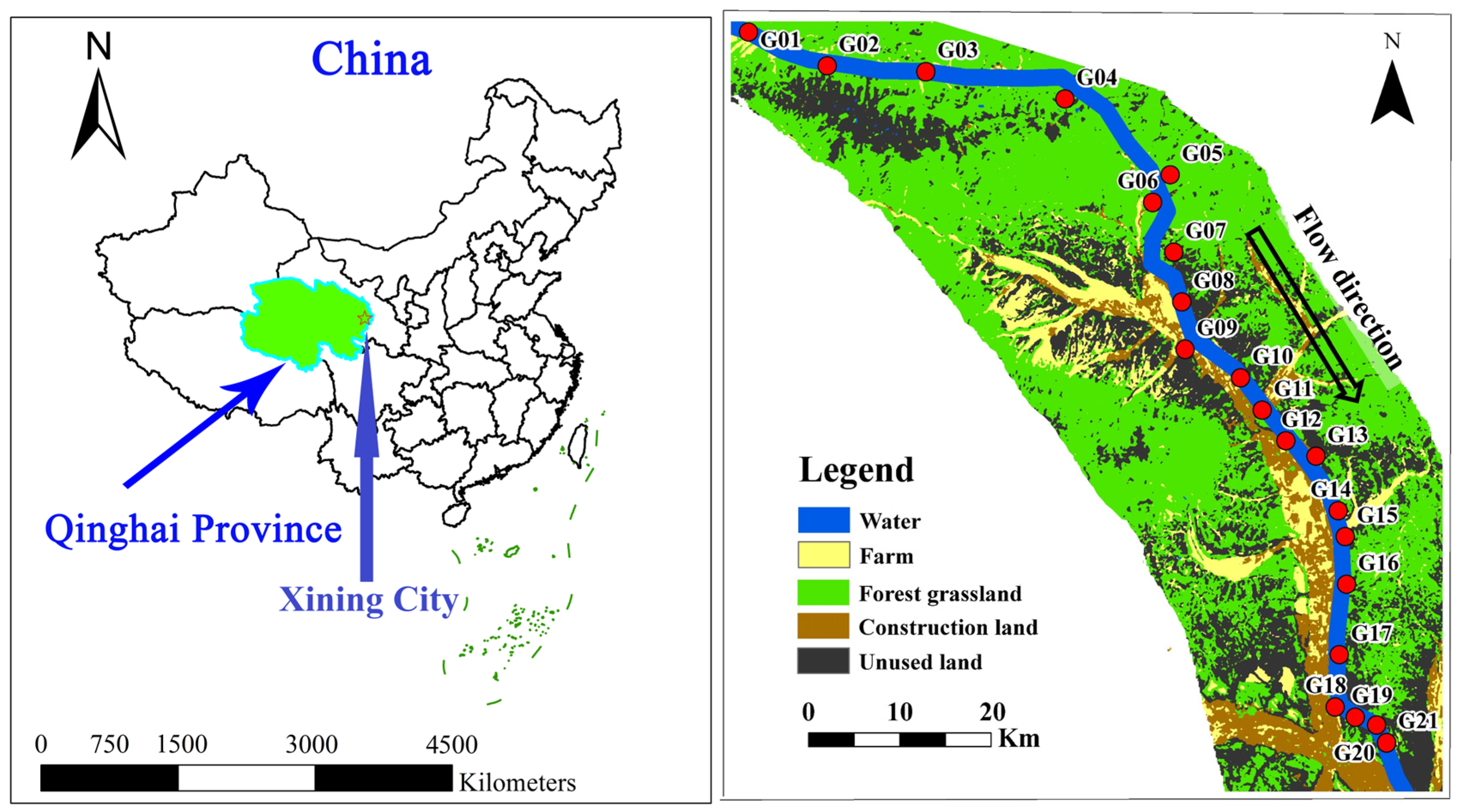
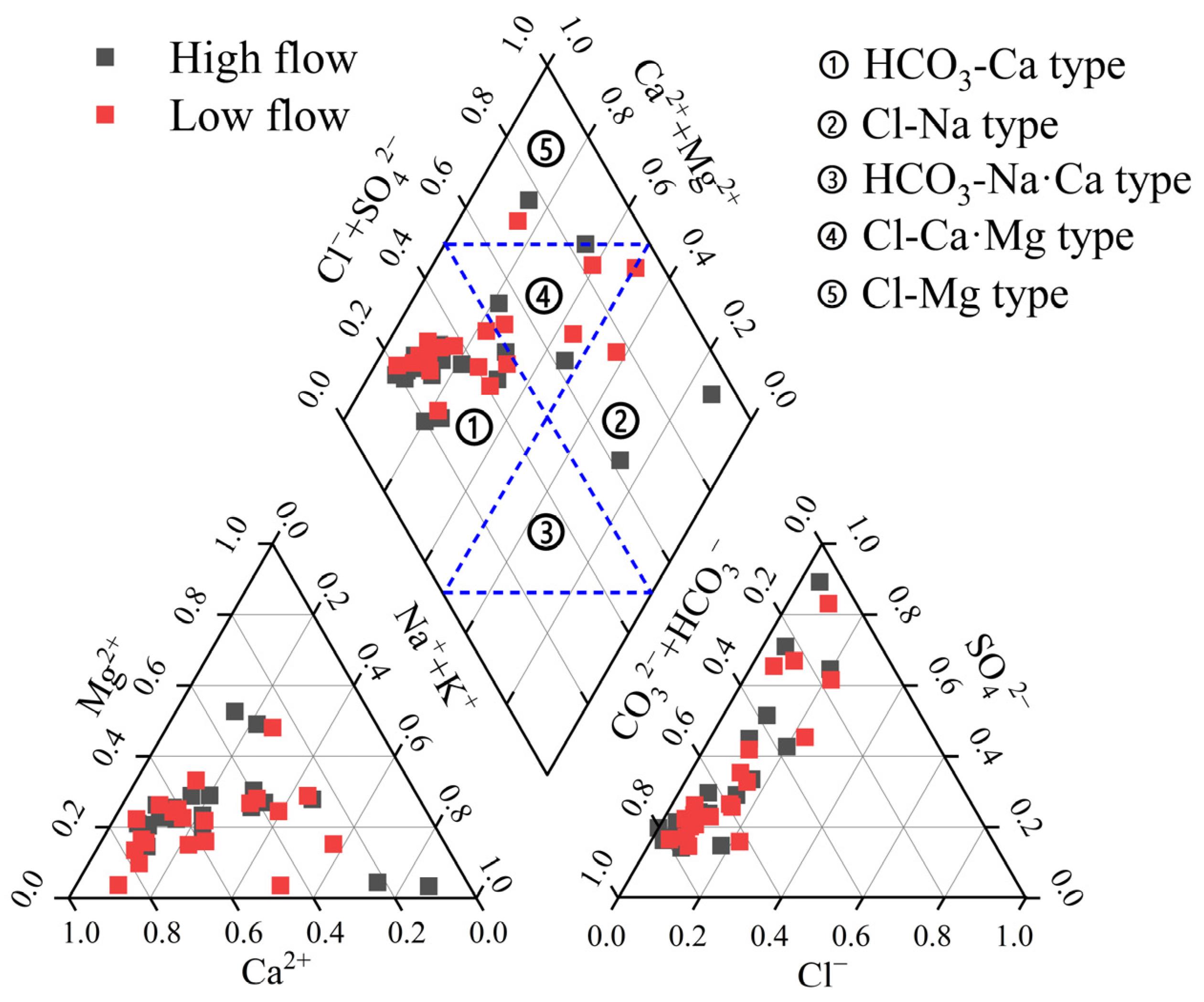
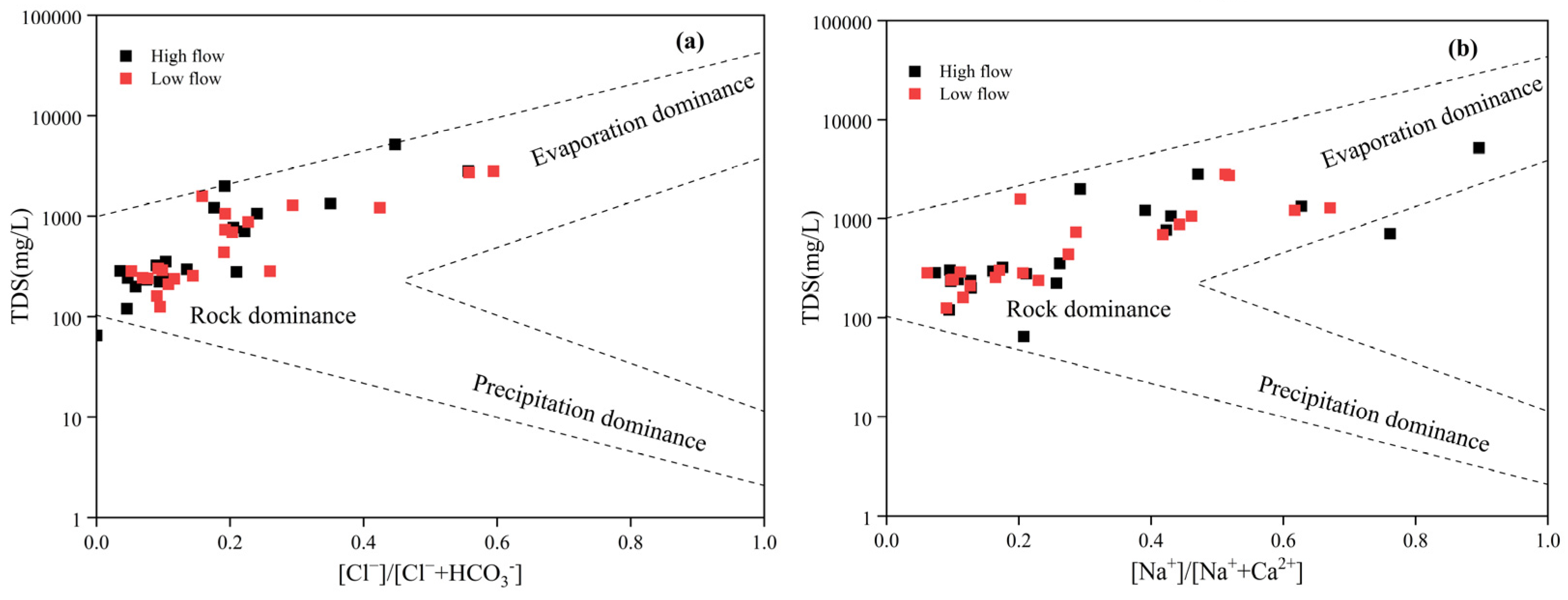
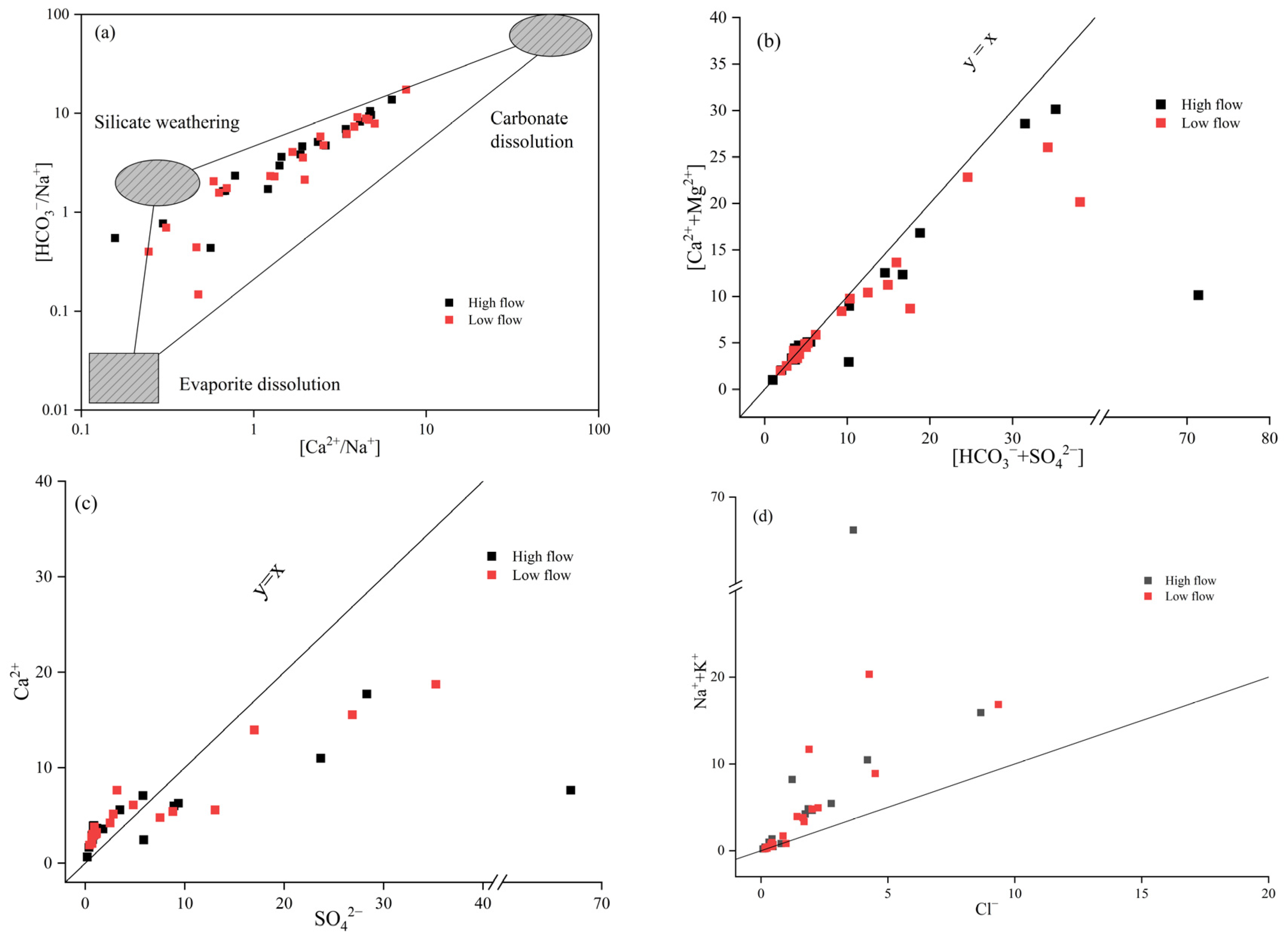
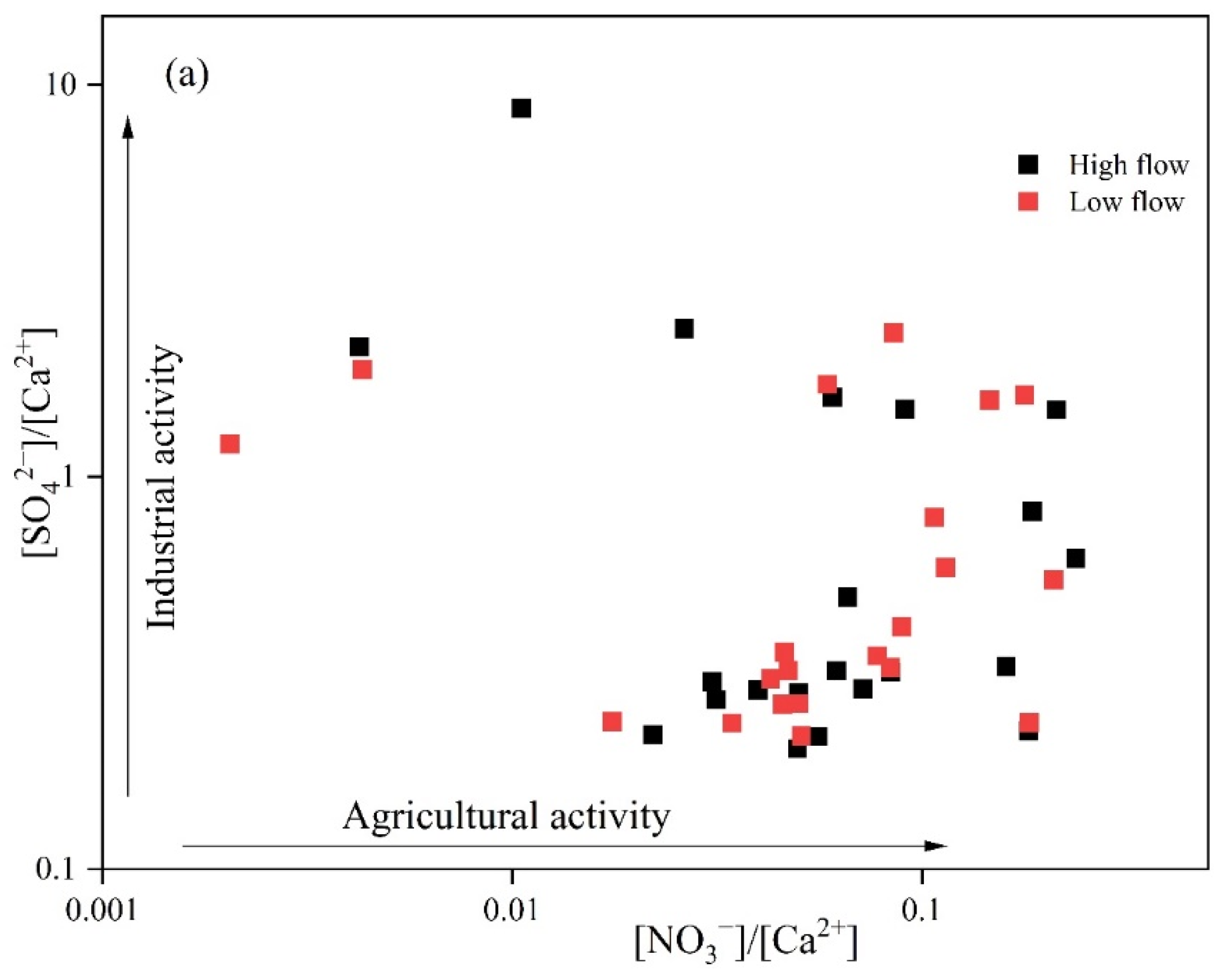
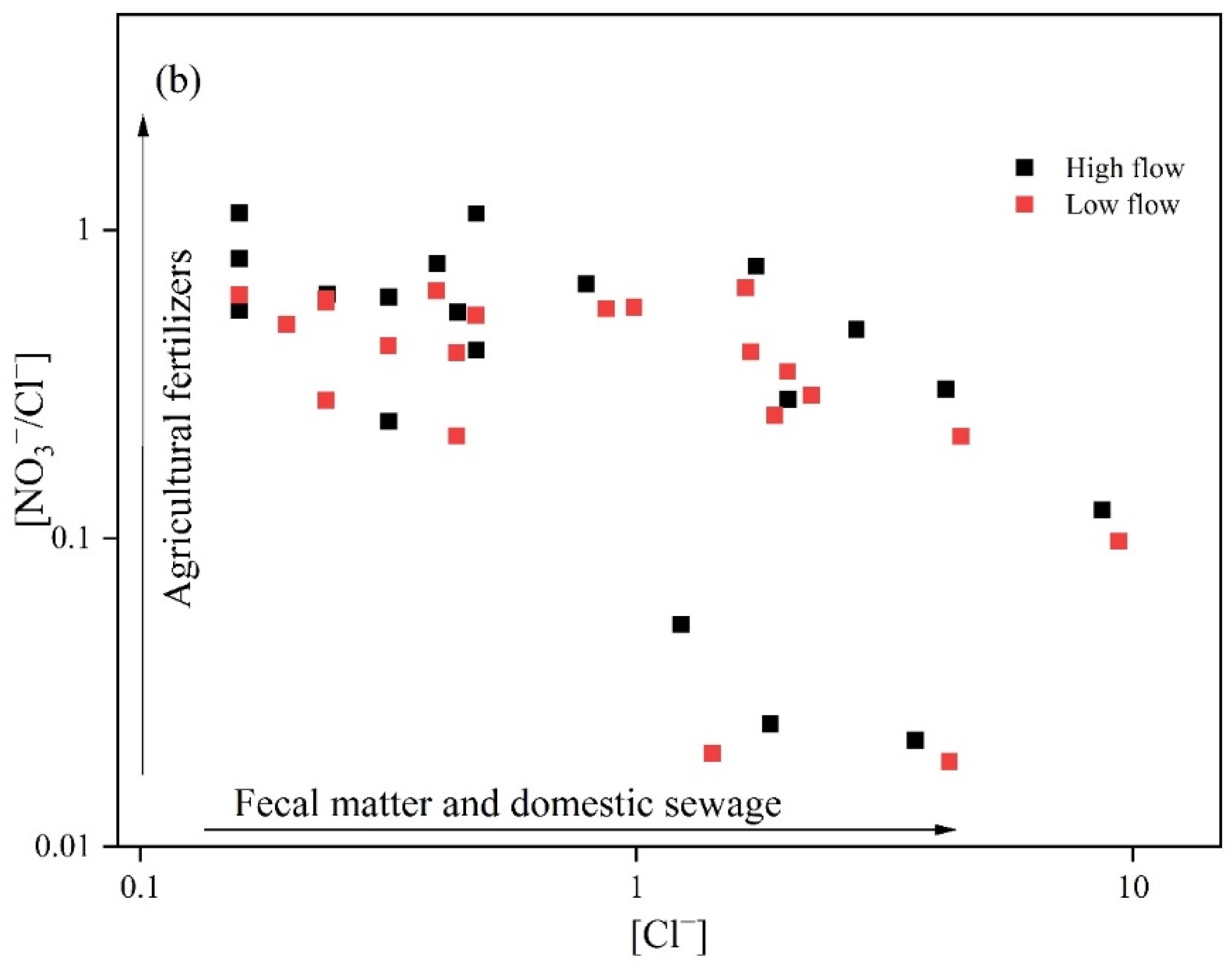
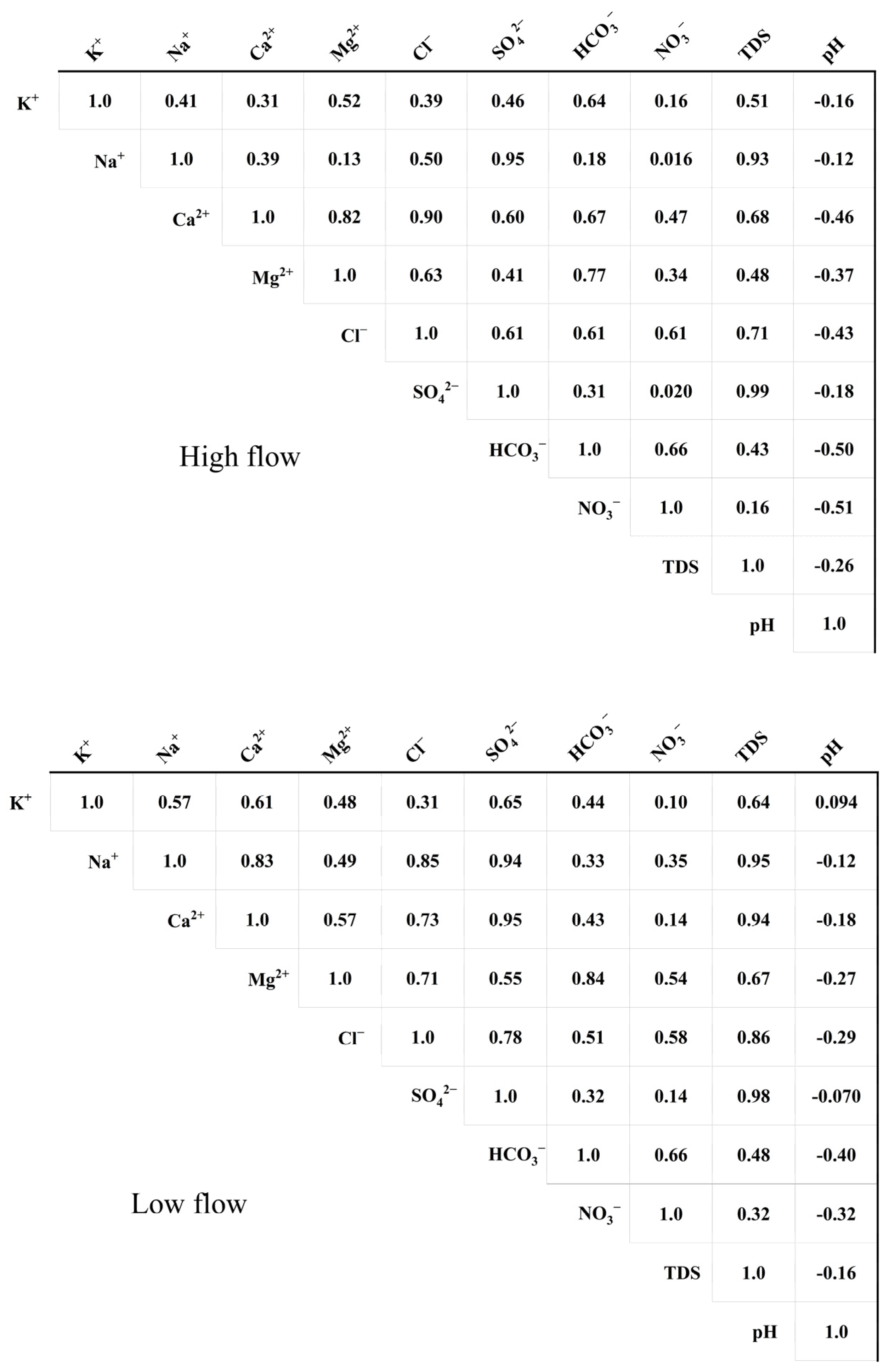
| Parameters | Range | Average | Exceedance Rate/(%) | Class III Groundwater Quality Standard * | |||
|---|---|---|---|---|---|---|---|
| HFS | LFS | HFS | LFS | HFS | LFS | ||
| pH | 6.60–8.31 | 6.80–8.20 | 7.53 | 7.64 | 0 | 0 | 6.50–8.50 |
| K+ | 1.44–24.2 | 1.51–27.8 | 6.13 | 6.86 | – | – | – |
| Na+ | 3.88–1514 | 4.38–452 | 136 | 90.0 | 14.3% | 19.1% | 200 |
| Ca2+ | 12.9–354 | 38.3–375 | 96.8 | 114 | – | – | – |
| Mg2+ | 4.40–211 | 0.97–126 | 41.0 | 33.6 | – | – | – |
| SO42− | 9.30–3210 | 20.1–1692 | 373 | 299 | 33.3% | 28.6% | 250 |
| Cl− | 2.81–307 | 5.60–332 | 50.90 | 57.5 | 4.76% | 4.76% | 250 |
| HCO3− | 47.7–576 | 91.6–514 | 278 | 276 | – | – | – |
| NO3− | 1.23–82.4 | 1.77–66.8 | 25.0 | 23.8 | 0 | 0 | 88.6 |
| TDS | 65.0–5189 | 126–2803 | 869 | 764 | 35.3% | 35.3% | 1000 |
| WQI Type | Grade | High-Flow Season | Low-Flow Season | ||
|---|---|---|---|---|---|
| Number | Rate (%) | Number | Rate (%) | ||
| Excellent water | I | 13 | 61.9 | 12 | 57.1 |
| Good water | II | 4 | 19.0 | 6 | 28.6 |
| Poor water | III | 2 | 9.52 | 3 | 14.3 |
| Very poor water | IV | 1 | 4.76 | 0 | 0 |
| Water unsuitable for drinking purposes | V | 1 | 4.76 | 0 | 0 |
| Parameters | High Flow | Low Flow | ||
|---|---|---|---|---|
| PC1 | PC2 | PC1 | PC2 | |
| SO42− | 0.921 | 0.316 | 0.903 | 0.376 |
| TDS | 0.885 | 0.396 | 0.951 | 0.233 |
| K+ | 0.859 | −0.106 | 0.786 | 0.015 |
| Na+ | 0.846 | 0.380 | 0.902 | 0.164 |
| Cl− | 0.756 | 0.596 | 0.725 | 0.637 |
| Mg2+ | 0.714 | 0.344 | 0.556 | 0.657 |
| HCO3− | 0.702 | 0.549 | 0.371 | 0.812 |
| Ca2+ | 0.652 | 0.535 | 0.916 | 0.127 |
| NO3− | 0.161 | 0.854 | 0.136 | 0.837 |
| pH | −0.191 | −0.790 | 0.059 | −0.684 |
| Eigenvalue | 6.83 | 1.14 | 6.23 | 1.66 |
| Contribution Rate (%) | 51.5 | 28.3 | 49.9 | 29.0 |
| Cumulative Contribution Rate (%) | 51.5 | 79.8 | 49.9 | 78.9 |
Disclaimer/Publisher’s Note: The statements, opinions and data contained in all publications are solely those of the individual author(s) and contributor(s) and not of MDPI and/or the editor(s). MDPI and/or the editor(s) disclaim responsibility for any injury to people or property resulting from any ideas, methods, instructions or products referred to in the content. |
© 2025 by the authors. Licensee MDPI, Basel, Switzerland. This article is an open access article distributed under the terms and conditions of the Creative Commons Attribution (CC BY) license (https://creativecommons.org/licenses/by/4.0/).
Share and Cite
Wang, L.; Yang, N.; Zhao, Y.; Zhang, Q. Research on the Features and Driving Factors of Shallow Groundwater Quality in Arid Areas, Northwest China. Water 2025, 17, 934. https://doi.org/10.3390/w17070934
Wang L, Yang N, Zhao Y, Zhang Q. Research on the Features and Driving Factors of Shallow Groundwater Quality in Arid Areas, Northwest China. Water. 2025; 17(7):934. https://doi.org/10.3390/w17070934
Chicago/Turabian StyleWang, Long, Nan Yang, Yang Zhao, and Qianqian Zhang. 2025. "Research on the Features and Driving Factors of Shallow Groundwater Quality in Arid Areas, Northwest China" Water 17, no. 7: 934. https://doi.org/10.3390/w17070934
APA StyleWang, L., Yang, N., Zhao, Y., & Zhang, Q. (2025). Research on the Features and Driving Factors of Shallow Groundwater Quality in Arid Areas, Northwest China. Water, 17(7), 934. https://doi.org/10.3390/w17070934






